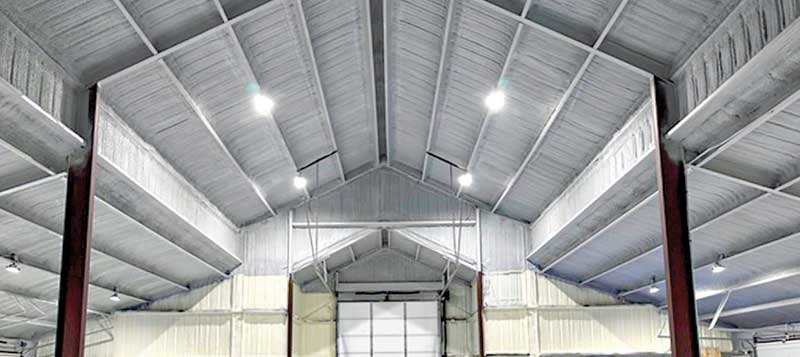Historically, metal buildings have been insulated with fiberglass batting systems or foam panels. Each has specific challenges. Fiberglass does not block moisture, and, in some cases, it holds moisture, which abates its insulation value and accelerates the corrosion of metal. Foam panels have some fire resistance but, in many cases, do not pass the National Fire Prevention Association (NFPA) code that is required: NFPA 286, Fire Test Evaluating Contribution of Wall and Ceiling Interior Finish (otherwise known as the “room corner burn” test). Neither foam panels nor fiberglass provides any structural rigidity for racking or wind panels uplift resistance.
Emerging fire barrier, single-step foamed-in-place insulation overcomes these shortcomings, including fire barrier challenges and thermal barrier compliance.
Underwriters Laboratories (UL) describes a thermal barrier as “a material or product that prevents or delays the ignition of a flammable surface, such as foam plastic insulation or metal composite material, in the event of a fire.”
Some emerging closed-cell spray polyurethane foam (SPF) products are now achieving better fire performance in the value insulation space. These new monolithic SPF products pass NFPA-275, Standard Method of Fire Tests for the Evaluation of Thermal Barriers. As a monolithic fire-rated solid, it is a fire and thermal protective barrier throughout the complete volume of the insulation all in one. Having its fire rating built into the insulation means fewer added steps, lower cost and risk versus a thermal barrier coating, cellulose, and other post-ad thermal barriers.
This is important for the metal construction industry because this technology serves both as continuous extreme R insulation (requiring 40 percent less material) and as a water barrier in a single-application solution, eliminating the need for a top coat or drywall to meet code requirements. Additionally, it significantly increases the structural strength of metal buildings and reduces wind damage potential.
Monolithic fire performance
Post-applied, “exception-based” thermal barriers become daunting when trying to ensure compliant, safe application. They must be properly applied, they require third-party inspection, and they are used only in “conditioned spaces.” In addition, as soon as the thermal barrier is breached, the fire protection of the flammable substrate is lost.
A monolithic fire barrier material will protect against fires from the outside in, as well as fires from the inside out. Top coats protect only one face of flammable insulation. They cannot provide unilateral fire protection from internal fires to wildfires (externally initiated fires), electrical shorts, wall fires, or lightning strikes, for instance.
By incorporating innovative fire and thermal barrier technologies within the spray foam, installers can attain all the benefits of continuous insulation, air barrier, moisture barrier, mold defense, structural rigidity, and high insulation value in their metal structures.
Reducing risk window
By having the thermal barrier integrated into the foam, the material becomes an effective fire barrier as soon as the chemical reaction finishes. The benefit is, fire safety is “built in” as soon as the foam reaction is complete, providing a “zero risk” window. This is very different from traditional methods where flammable plastic insulation materials, both panels and continuous, require an additional thermal barrier post installation. That gap in time waiting for the post-applied thermal barrier poses a life-safety risk and liability.
Embracing the benefits
In the end, architects, builders, contractors, and building owners care about better value. An NFPA-275-tested and third-party-certified thermal barrier high-R-value insulation substantially reduces total costs, including speed of installation, life safety, and building sustainability. The end-user value across the complete construction hierarchy results in significant cost savings both initially and throughout the structure’s life.
These new technologies are improving total costs and margins in major areas of construction, such as commercial, government, union, and prevailing wage projects. Benefits translate into other growing metal construction markets, such as agriculture, commercial cold-storage facilities, grow houses, outbuildings, and military and aviation hangars.
The elimination of steps translates into lower costs, more efficient installations, and, most important, a lower risk for the loss of life and property…a true trifecta of value.
Richard J. Barone, Jr is co-founder and executive vice-president of operations for Firestable Insulation Co. As an entrepreneur and inventor, he has established several fire technology companies in his 20-plus years in fire protection.



